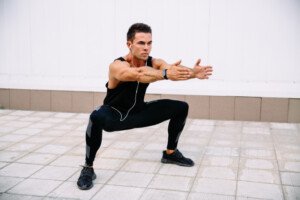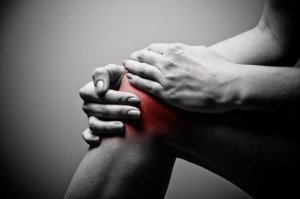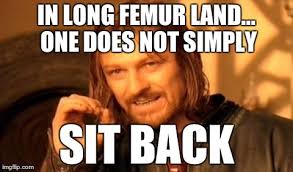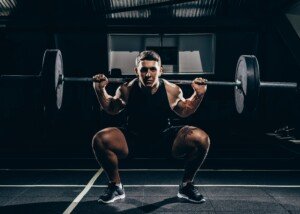Long femurs are the bane of anyone who’s working on their back squat form.
Those with long femurs may wonder if this can cause knee problems even in the absence of doing back squats.
In the world of fitness and exercise, the term “long femur” does not refer to absolute femur length.
It refers to relative femur length. For example, a 6’2 man may have longer femurs than does a 5’7 man.
However, the femurs of the tall person are six inches shorter than his torso and equal in length to his shins.
The femurs of the shorter man are one inch longer than his torso and two inches longer than his shins.
Who’s going to have a rougher time executing good form in the back squat?
Who’s going to be leaning forward more to avoid falling backwards?
Answer: The shorter man.
And as we all know, the more pronounced the forward lean in the back squat, the more stress is placed on the low back – and that’s bad news!
Some people with “long femurs” can compensate by developing high flexibility in their ankles that allows pronounced dorsiflexion – which yields the ability to move their knee well-past over their foot.
Unfortunately, this isn’t a prime position for the knee joint and results in added stress to the knees.
Avoiding the back squat seems like a simple solution. After all, there are other ways to strengthen the quads and glutes, and other ways to sculpt them as well.
But what about the activities of daily living?
What about lowering into a squat to pick something heavy off the floor?
Those long femurs will get in the way, forcing the person to lean more forward than if they had a shorter femur-to-torso ratio or a shorter femur-to-shin ratio.
One might say they could compensate with a wide stance (which can be done with the back squat as well).
But a wide stance for someone with very undesirable body proportions can only compensate so much.
Furthermore, the wider the stance, the more involvement of the naturally weaker hip adductor muscles.
A very wide stance is not the ideal squat position when it’s time to pick up something heavy, especially if one has stiff hip adductors.
Nevertheless, there’s always going to be a need to squat down to lift something heavy.
People with “short femurs” (i.e., relative to torso and shin length, regardless of overall height) are at a biomechanical advantage with these kinds of movements.
“Long femurs place additional stress on the knee when performing squatting activities by increasing the knee bend angle,” says Dr. Logan Thomas, a physical therapist in Parker City, IN.
The knee bend angle is “how much knee flexion is occurring,” adds Dr. Thomas. “The more knee flexion, the more stress on the joint.”
Long femurs have the potential to cause issues for “any positions that require more knee bend.
“Olympic weightlifting, squatting to work on cars or yardwork, kneeling to clean, etc.”
How to Prevent Knee Problems if You Have Long Femurs
“Resultant knee problems may include arthritis, patellar tendinopathy or meniscus tears,” says Dr. Thomas.
A person with long femurs who faithfully strength trains may not develop these problems.
But they’re more likely to occur from lifting in everyday life to people who don’t strength train or work out.
When it’s time to get into squat positions for yardwork, household duties or tasks at the workplace, they may over time develop problems with their knees.
Whether a person with long femurs regularly strength trains or not, they can learn to use a wide stance (Sumo squat) when lowering into a squat to perform any task.

Wide squat. Freepik.com/freepic.diller
The caveat is that this will feel uncomfortable to those with stiff and weak hip adductors (the inner thigh muscles).
You’ll need to make these muscles more limber and stronger. Yoga is a good way to accomplish this. Many basic yoga moves will help stretch these muscles.
And of course, simply working on wide-stance squats with only your body weight will go a long way at training these muscles.
 Dr. Thomas a physical therapist, and strength and conditioning coach who is passionate about patient education. He believes the most important and often overlooked step in the process to becoming pain-free is understanding the anatomy and biomechanics of your body.
Dr. Thomas a physical therapist, and strength and conditioning coach who is passionate about patient education. He believes the most important and often overlooked step in the process to becoming pain-free is understanding the anatomy and biomechanics of your body.
 Lorra Garrick is a former personal trainer certified by the American Council on Exercise. At Bally Total Fitness she trained clients of all ages for fat loss, muscle building, fitness and improved health.
Lorra Garrick is a former personal trainer certified by the American Council on Exercise. At Bally Total Fitness she trained clients of all ages for fat loss, muscle building, fitness and improved health.
.



























